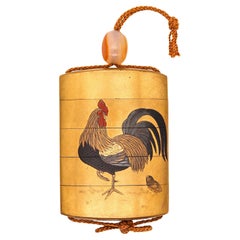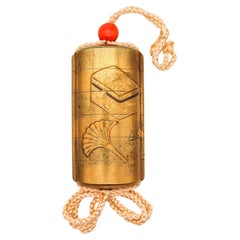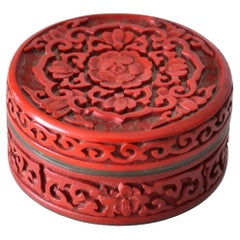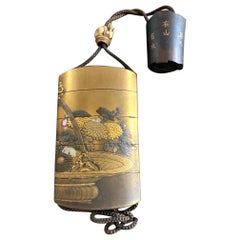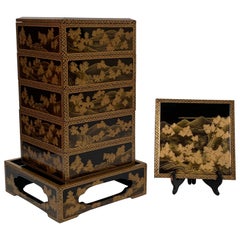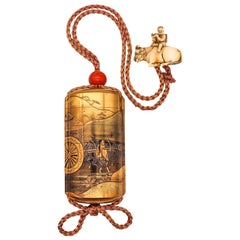Miami - Lacquer
13
to
421
144
13
13
13
5
8
5
3
1
1
1
11
6
4
4
3
13
8
5
5
4
Item Ships From: Miami
Early 20th Century Burmese Lacquered Tray, “Pagan Bya”
Located in Atlanta, GA
Burmese (Myanmar) Lacquerware has a long tradition dating back to the 13th century. Lacquer in Burma is called “Thitsi” meaning the sap of a Thitsi Tree (Melanhorrea Usitata). Typica...
Category
Early 20th Century Burmese Miami - Lacquer
Materials
Bamboo, Lacquer
Japan 1870 Meiji Period Round Five Drawer Inro Lacquered Wood With Flying Cranes
Located in Miami, FL
Japanese Inro from the Meiji Period (1868-1912).
Beautiful Inro, created in Japan during the Meiji imperial period, circa 1870. It was carefully crafted in carved precious wood with...
Category
1870s Japanese Meiji Antique Miami - Lacquer
Materials
Giltwood, Lacquer, Wood, Ebony
Early 20th Century Burmese Lacquered Tray, “Pagan Bya”
Located in Atlanta, GA
Burmese (Myanmar) Lacquerware has a long tradition dating back to the 13th century. Lacquer in Burma is called “Thitsi” meaning the sap of a Thitsi Tree (Melanhorrea Usitata). Typica...
Category
Early 20th Century Burmese Miami - Lacquer
Materials
Bamboo, Lacquer
Japan 1810 Kajikawa Edo Period Five Drawer Inro Lacquered Gilt Wood With Rooster
Located in Miami, FL
Japanese Inro from the Edo period (1615-1868) created by Kajikawa.
Beautiful Inro, created in Japan by one of the Kajikawa family during the Edo period (1615-1868), circa 1810. Has been carefully crafted in carved precious wood with applications of gilding maki-e and decorated with Japonism patterns. All dan trays are attached together with a himo cord. The detailed craftsmanship was a true pleasure to behold.
Period: Edo period (1615-1868). Shogunate.
Approximate Date: 1790-1810
Motif: A family of birds consisting of a cockerel, the hen and three chicks.
Drawers: Five.
Shape: Rectangular navette.
Technique: Carved wood, lacquer and decorated in iroe-hiramaki-e on a gold ground.
Ojime: 15mm 20mm, oval carved from natural translucent agate.
Netsuke: None
Weight: 47.70 Grams.
Measurements: Inro is 78 mm by 55 mm by 18 mm (3.07 x 2.17 x 0.71 Inches).
Signatures: Kajikawa Saku, in the underside with the signature KAJIKAWA. By a member of the Kajikawa family, signed Kajikawa 梶川 Japan, late 18th century to early 19th century, Edo period (1615-1868).
The Kajikawa family
Kajikawa family, flourished in the 19th century, they was Japanese lacquerware artists whose school in Edo (now Tokyo) flourished for more than 200 years. This family is perhaps the most famous of all the dynasties of Japanese lacquer artists, and certainly the name most often found on inro. The family is said to have been founded by Hikobei at Edo in the early 17th century, although some claim that the family’s great reputation really stemmed from his son and pupil Kyujiro. In any event, Hikobei worked for the shogunate, as did his successors until well into the 19th century. Kijirō excelled in designing particularly delicate lacquer inrō, portable medicine cases...
Category
1810s Japanese Edo Antique Miami - Lacquer
Materials
Agate, Gold
Japan 1800 Edo Period Six Drawer Inro In Lacquered Gilt Wood With Utensils
Located in Miami, FL
Japanese Inro from the Edo Period (1603-1867).
Beautiful Inro, created in Japan during the Edo period (Shogunate), circa 1800. It was carefully crafted in carved precious wood with ...
Category
Early 1800s Japanese Edo Antique Miami - Lacquer
Materials
Coral
Antique Chinese Cinnabar, Brass and Enamel Box
Located in Miami, FL
A crisply carved antique Chinese red cinnabar lacquer lidded round box with blue enamel interior and brass fittings. The "dragon's blood" trinket box has a fine peony, foliate and fl...
Category
19th Century Chinese Qing Antique Miami - Lacquer
Materials
Enamel, Brass
Antique Chinese Cinnabar Box
Located in Miami, FL
A fine antique Chinese red cinnabar lacquer lidded round box carved with a scene with a young boy and a seated elderly bearded sage within a rocky landscape with trees. The "dragon's...
Category
19th Century Chinese Qing Antique Miami - Lacquer
Materials
Lacquer
Japan 1900 Meiji Miniature Hanagamidai Cabinet in Gilded Wood & Sterling Silver
Located in Miami, FL
Miniature hanagamidai cabinet from the Japan meiji (1858-1912) period.
Gorgeous and rare miniature drawers hanagamidai (cosmetic cabinet), created in the imperial Japan during the...
Category
Early 1900s Japanese Meiji Antique Miami - Lacquer
Materials
Gold, Silver, Sterling Silver
Large Domed Chinese Cinnabar Box
Located in Miami, FL
A large vintage Chinese red cinnabar box with deep relief carved lid depicting peonies, trees and a landscape with a palace. The round box has...
Category
1930s Chinese Chinese Export Vintage Miami - Lacquer
Materials
Brass
Chinese Soapstone, Semiprecious Hardstone and Lacquer Folding Screen
Located in Miami, FL
This stunning Chinese screen is an exceptionally well-crafted piece, beautifully decorated with intricate semiprecious hardstone carvings. Measuring ...
Category
Mid-20th Century Chinese Chinese Export Miami - Lacquer
Materials
Wood, Precious Stone
Early 20th Century, Large Burmese Betel Box, “Kun It”
Located in Atlanta, GA
Burmese (Myanmar) Lacquerware has a long tradition dating back to the 13th Century. Lacquer in Burma is called “Thitsi” meaning the sap of a Thitsi Tree (Melanhorrea Usitata). Typica...
Category
Early 20th Century Burmese Miami - Lacquer
Materials
Bamboo, Lacquer
Early 20th Century Burmese Lacquer Offering Vessel, Hsun Ok
Located in Atlanta, GA
Burmese (Myanmar) lacquer ware has a long tradition dating back to the 13th century. Lacquer in Burma is called “Thitsi” meaning the sap of a Thitsi Tree (Melanhorrea Usitata). Typically, bamboo and wood are used as a frame or base in making lacquer work.
This covered offering vessel is called a “Hsun Ok...
Category
1920s Burmese Vintage Miami - Lacquer
Materials
Wood, Lacquer
Early 20th Century Burmese Lacquered Tray Stand, “Dang lan”
Located in Atlanta, GA
Burmese (Myanmar) lacquer ware has a long tradition dating back to the 13th century. Lacquer in Burma is called “Thitsi” meaning the sap of a Thitsi Tree (Melanhorrea Usitata). Typic...
Category
Mid-20th Century Burmese Miami - Lacquer
Materials
Bamboo, Lacquer
Related Items
Antique Japanese Inro by Shigehide Edo Period
Located in Atlanta, GA
This exquisite four-case lacquered inro was dated to the latter part of 18th century to early 19th century (Edo period) and made by Shigehide. The opposite sides of the inro together features a lavish flower arrangement in a bamboo basket (ikebana). The detailed craftmanship was a true pleasure to behold. Mostly Takamaki-e (high relief) were used to texturize the delicate petals of the chrysanthemums, on which different shades of gold were used to create contrast. Raden (mother of pearl) shells were also used to highlight some leaves, rendering the piece an interesting balance of color and material. The interior was completed in a mottled gold finish. It was signed Shigehide on the bottom with a Kao. There is a small carved rabbit ojime bead...
Category
Late 18th Century Japanese Japonisme Antique Miami - Lacquer
Materials
Wood, Lacquer
Japanese Maki-e Lacquer Stacking Box, Jubako, Meiji Period, Japan
Located in Austin, TX
A fine and impressive Japanese gold maki-e decorated black lacquer five-tier jubako with presentation tray, two lids, and the original tomobako storage box, Meiji period, late 19th c...
Category
Late 19th Century Japanese Meiji Antique Miami - Lacquer
Materials
Lacquer
Chinese Carved Cinnabar Planter
Located in Cypress, CA
Unique Chinese beautifully carved cinnabar planter with three cranes forming the planter, second half of the 20th century.
Category
Late 20th Century Chinese Miami - Lacquer
Materials
Lacquer
Lacquer Table, Late Meiji Period, Japan, circa 1900
Located in Buenos Aires, Buenos Aires
Lacquer table, Art Deco period, Japan, circa 1900.
Category
Early 1900s Japanese Art Deco Antique Miami - Lacquer
Materials
Lacquer
Japanese Lacquer and Cinnabar "Samurai" Cabinet, Inaba Family, Edo Period
Located in Troy, NY
Exceptionally large and rare lacquer cabinet. According to the heraldry, visible on the headgear in one of the panels, it was made for the Inaba family, a high ranking Daimyo family,...
Category
Late 19th Century Japanese Edo Antique Miami - Lacquer
Materials
Wood
Chinese Carved Cinnabar Pot with Two Dragons
Located in New York, NY
A Chinese cinnabar pot, produced within the Daoguang period (1890-1920), the body beautifully carved, detailing two celestial dragons, the interior pai...
Category
Early 20th Century Chinese Miami - Lacquer
Materials
Lacquer
19th Century Chinese Export Oval Cinnabar Box
Located in West Palm Beach, FL
19th Century Chinese Export Oval Cinnabar Box
This 19th Century Chinese Export Oval Cinnabar Box is a testament to exceptional craftsmanship and artistr...
Category
19th Century Chinese Chinese Export Antique Miami - Lacquer
Materials
Metal
Elegant Japanese Edo Period Rack
Located in New York, NY
This refined object dates to the first half of the 19th century, and was probably used for obi, kimono sashes, which were hung over it. The gold decorations on the black-lacquered g...
Category
1830s Japanese Edo Antique Miami - Lacquer
Materials
Lacquer
Japanese Lacquer Incense Burner, Koro, Edo period, mid 19th century, Japan
Located in Austin, TX
An elegant and refined Japanese lacquer koro, incense burner, in the form of a chaire, tea caddy, Edo Perio, mid 19th century, Japan.
The barrel shaped koro formed as a traditional ...
Category
Mid-19th Century Japanese Edo Antique Miami - Lacquer
Materials
Copper
Japanese Maki-e Lacquer Document Box, Edo Period, early 19th Century, Japan
Located in Austin, TX
A spectacular Japanese maki-e lacquer lidded box, possibly a writing box, suzuribako, decorated with images of folding fans, ogi, Edo Period, earl...
Category
Early 19th Century Japanese Edo Antique Miami - Lacquer
Materials
Coral
Japanese Lacquer Box, Kobako, "The Ivy Way", Edo Period, 19th Century, Japan
Located in Austin, TX
An exquisite Japanese tall lacquer box for incense implements, kobako, with a scene from The Tales of Ise, chapter 9, "The Ivy Way Through Mt. Utsu", Edo ...
Category
Mid-19th Century Japanese Edo Antique Miami - Lacquer
Materials
Lacquer
Japanese Lacquer Stationery Box, Suzuribako, Edo Period, 19th c, Japan
Located in Austin, TX
A fine and elegant Japanese lacquer box for writing implements or stationery, suzuribako, with an image of a Shinto shrine, Edo Period, mid-19th century, circa 1840, Japan.
The exqu...
Category
Mid-19th Century Japanese Edo Antique Miami - Lacquer
Materials
Gold Leaf
Free Shipping
H 1.75 in W 6.25 in D 9 in
Previously Available Items
Japan 1810 Edo Period Takamaki-e Five Drawer Inro In Lacquered Wood With A Hawk
Located in Miami, FL
Japanese Inro with a Hawk from the Edo Period (1603-1867).
Beautiful Inro, created in Japan during the Edo period (Shogunate), circa 1810. It was carefully crafted in carved preciou...
Category
1810s Japanese Edo Antique Miami - Lacquer
Materials
Coral, Silver
H 3.5 in W 1.62 in D 1.5 in
Japan 1830 Edo Period Six Drawer Inro In Lacquered Gilt Wood With A Carriage
Located in Miami, FL
Japanese Inro from the Edo Period (1603-1867).
Beautiful Inro, created in Japan during the Edo period (Shogunate), circa 1830. It was carefully crafted in carved precious wood with applications of lacquer and decorated with orientalism patterns. All dan trays are attached together with a himo cord. The detailed craftsmanship was a true pleasure to behold.
Period: Edo 1606-1867, Shogunate.
Approximate Date: 1830
Motif: An elaborated three-dimensional royal carriage with a silvered bull and a richly dressed court companion. All surrounded by a road and sinuous mountainous landscape with trees and plants.
Drawers: Six.
Shape: Oval
Technique: Carved wood, Lacquer, hiramaki-e, takamaki-e, Gilding, Silvered.
Ojime: 15mm, round sphere carved from natural translucent carnelian
Netsuke: Patinated carved seated child playing a shakuhachi (flute) in a resting bull, signed.
Weight: 67.60 Grams.
Measurements: Inro is 92 mm by 27 mm by 38 mm (3.60 x 1.06 x 1.50 Inches).
The Edo Period
The Edo period or Tokugawa period is the period between 1603 and 1867 in the history of Japan, when Japan was under the rule of the Tokugawa shogunate and the country's 300 regional daimyo. Emerging from the chaos of the Sengoku period, the Edo period was characterized by economic growth, strict social order, isolationist foreign policies, a stable population, perpetual peace, and popular enjoyment of arts and culture. The period derives its name from Edo (now Tokyo), where on March 24, 1603, the shogunate was officially established by Tokugawa Ieyasu. The period came to an end with the Meiji Restoration and the Boshin War, which restored imperial rule to Japan. The Tokugawa (or Edo) period brought 250 years of stability to Japan. The political system evolved into what historians call bakuhan, a combination of the terms bakufu and han (domains) to describe the government and society of the period.[3] In the bakuhan, the shōgun had national authority and the daimyo had regional authority. This represented a new unity in the feudal structure, which featured an increasingly large bureaucracy to administer the mixture of centralized and decentralized authorities. The Tokugawa became more powerful during their first century of rule: land redistribution gave them nearly seven million koku, control of the most important cities, and a land assessment system reaping great revenue
Inro
Is a traditional Japanese case for holding small objects, suspended from the obi (sash) worn around the waist when wearing a kimono. They are often highly decorated with various materials such as lacquer and various techniques such as maki-e, and are more decorative than other Japanese lacquerware. Because traditional Japanese dress...
Category
1830s Japanese Edo Antique Miami - Lacquer
Materials
Gold, Silver
H 3.6 in W 1.5 in D 1.06 in
Large Domed Chinese Cinnabar Box
Located in Miami, FL
A large vintage Chinese red cinnabar box with deep relief carved lid depicting flowers, leaves and a dragon. The round box has a domed lid and...
Category
1930s Chinese Chinese Export Vintage Miami - Lacquer
Materials
Brass
Chinese Cinnabar Box
Located in Miami, FL
Vintage Chinese rectangular vanity, jewelry or trinket red cinnabar box with carved lid depicting flowers, leaves and geometric motifs with black lacq...
Category
1930s Chinese Chinese Export Vintage Miami - Lacquer
Materials
Lacquer
Early 20th Century Burmese Lacquer Offering Vessel, Hsun Ok
Located in Atlanta, GA
Burmese (Myanmar) lacquer ware has a long tradition dating back to the 13th century. Lacquer in Burma is called “Thitsi” meaning the sap of a Thitsi Tree (Melanhorrea Usitata). Typically, bamboo and wood are used as a frame or base in making lacquer work.
This covered vessel is called a “Hsun Ok...
Category
Early 20th Century Burmese Miami - Lacquer
Materials
Wood, Lacquer
Cloisonné Enamel-Inset Lacquer Panel
Located in Miami, FL
Large Chinese cloisonné enamel-inset rectangular lacquer wall panel decorated in high relief with lotus flowers, leaves and king birds. The background...
Category
19th Century Chinese Antique Miami - Lacquer
Recently Viewed
View AllMore Ways To Browse
Japanese Ink Stone
Antique Japanese Inro
19th Century Carved Chinese Fan
Asian Music Box
Chinese Lacquerware
Japanese Cinnabar
Japanese Lacquered Miniature
Japanese Lacquer Plaque
Antique Japanese Knife
Maki Tray
Burmese Offering Bowl
Japanese Negoro Lacquer
Inro Netsukes
Japanese Suzuribako
Cinnabar Dragon
Japanese Laquered
Japanese Picnic
Chinese Red Cinnabar Box



